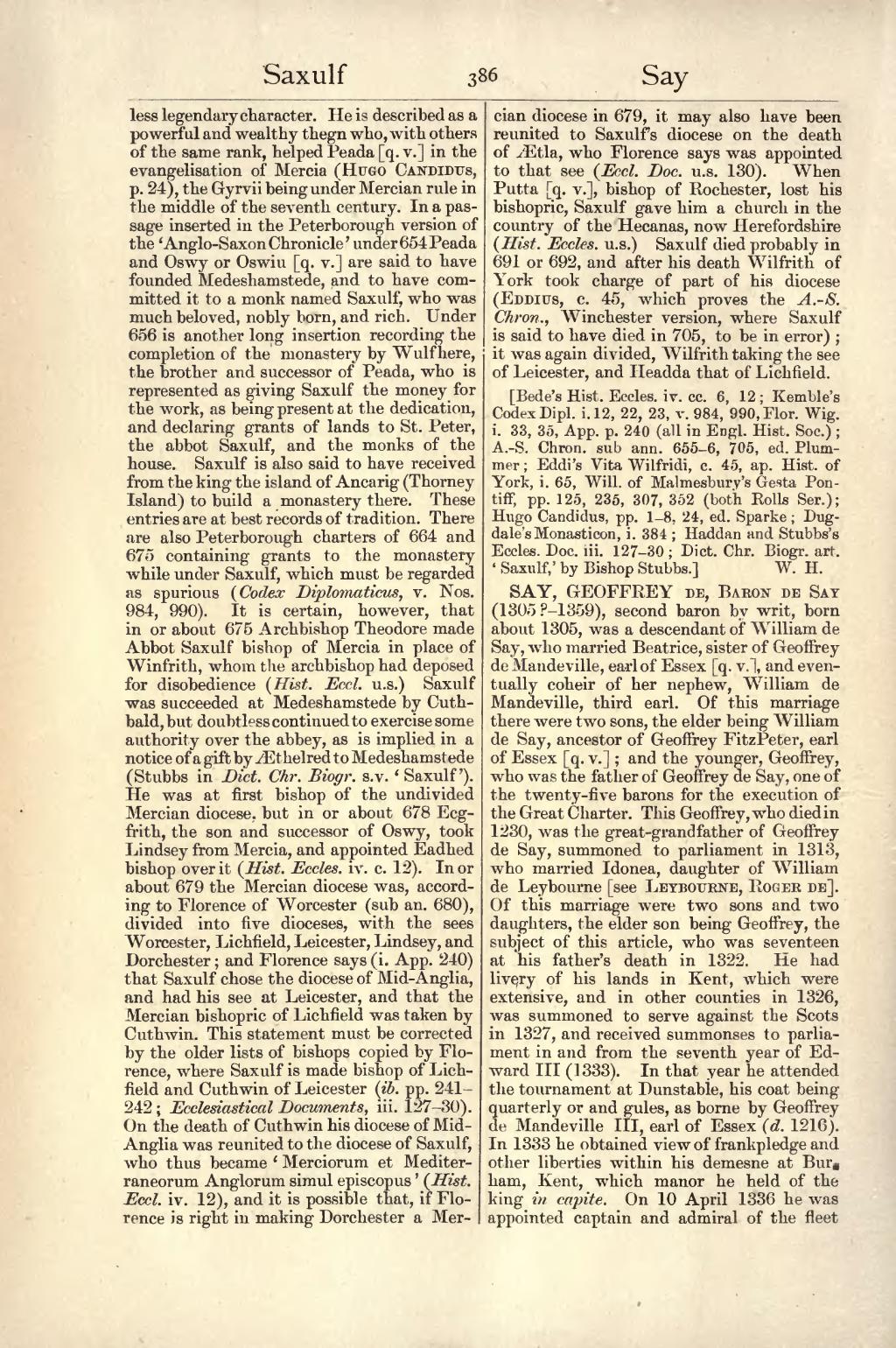less legendary character. He is described as a powerful and wealthy thegn who, with others of the same rank, helped Peada [q. v.] in the evangelisation of Mercia (Hugo Candidus, p. 24), the Gyrvii being under Mercian rule in the middle of the seventh century. In a passage inserted in the Peterborough version of the ‘Anglo-Saxon Chronicle’ under 654 Peada and Oswy or Oswiu [q. v.] are said to have founded Medeshamstede, and to have committed it to a monk named Saxulf, who was much beloved, nobly born, and rich. Under 656 is another long insertion recording the completion of the monastery by Wulfhere, the brother and successor of Peada, who is represented as giving Saxulf the money for the work, as being present at the dedication, and declaring grants of lands to St. Peter, the abbot Saxulf, and the monks of the house. Saxulf is also said to have received from the king the island of Ancarig (Thorney Island) to build a monastery there. These entries are at best records of tradition. There are also Peterborough charters of 664 and 675 containing grants to the monastery while under Saxulf, which must be regarded as spurious (Codex Diplomaticus, v. Nos. 984, 990). It is certain, however, that in or about 675 Archbishop Theodore made Abbot Saxulf bishop of Mercia in place of Winfrith, whom the archbishop had deposed for disobedience (Hist. Eccl. u.s.). Saxulf was succeeded at Medeshamstede by Cuthbald, but doubtless continued to exercise some authority over the abbey, as is implied in a notice of a gift by Æthelred to Medeshamstede (Stubbs in Dict. Chr. Biogr. s.v. ‘Saxulf’). He was at first bishop of the undivided Mercian diocese, but in or about 678 Ecgfrith, the son and successor of Oswy, took Lindsey from Mercia, and appointed Eadhed bishop over it (Hist. Eccles. iv. c. 12). In or about 679 the Mercian diocese was, according to Florence of Worcester (sub an. 680), divided into five dioceses, with the sees Worcester, Lichfield, Leicester, Lindsey, and Dorchester; and Florence says (i. App. 240) that Saxulf chose the diocese of Mid-Anglia, and had his see at Leicester, and that the Mercian bishopric of Lichfield was taken by Cuthwin. This statement must be corrected by the older lists of bishops copied by Florence, where Saxulf is made bishop of Lichfield and Cuthwin of Leicester (ib. pp. 241–242; Ecclesiastical Documents, iii. 127–30). On the death of Cuthwin his diocese of Mid-Anglia was reunited to the diocese of Saxulf, who thus became ‘Merciorum et Mediterraneorum Anglorum simul episcopus’ (Hist. Eccl. iv. 12), and it is possible that, if Florence is right in making Dorchester a Mercian diocese in 679, it may also have been reunited to Saxulf's diocese on the death of Ætla, who Florence says was appointed to that see (Eccl. Doc. u.s. 130). When Putta [q. v.], bishop of Rochester, lost his bishopric, Saxulf gave him a church in the country of the Hecanas, now Herefordshire (Hist. Eccles. u.s.). Saxulf died probably in 691 or 692, and after his death Wilfrith of York took charge of part of his diocese (Eddius, c. 45, which proves the A.-S. Chron., Winchester version, where Saxulf is said to have died in 705, to be in error); it was again divided, Wilfrith taking the see of Leicester, and Headda that of Lichfield.
[Bede's Hist. Eccles. iv. cc. 6, 12; Kemble's Codex Dipl. i. 12, 22, 23, v. 984, 990, Flor. Wig. i. 33, 35, App. p. 240 (all in Engl. Hist. Soc.); A.-S. Chron. sub ann. 655–6, 705, ed. Plummer; Eddi's Vita Wilfridi, c. 45, ap. Hist. of York, i. 65, Will. of Malmesbury's Gesta Pontiff, pp. 125, 235, 307, 352 (both Rolls Ser.); Hugo Candidus, pp. 1–8, 24, ed. Sparke; Dugdale's Monasticon, i. 384; Haddan and Stubbs's Eccles. Doc. iii. 127–30; Dict. Chr. Biogr. art. ‘Saxulf,’ by Bishop Stubbs.]
SAY, GEOFFREY de, Baron de Say (1305?–1359), second baron by writ, born about 1305, was a descendant of William de Say, who married Beatrice, sister of Geoffrey de Mandeville, earl of Essex [q. v.], and eventually coheir of her nephew, William de Mandeville, third earl. Of this marriage there were two sons, the elder being William de Say, ancestor of Geoffrey FitzPeter, earl of Essex [q. v.]; and the younger, Geoffrey, who was the father of Geoffrey de Say, one of the twenty-five barons for the execution of the Great Charter. This Geoffrey, who died in 1230, was the great-grandfather of Geoffrey de Say, summoned to parliament in 1313, who married Idonea, daughter of William de Leybourne [see Leybourne, Roger de]. Of this marriage were two sons and two daughters, the elder son being Geoffrey, the subject of this article, who was seventeen at his father's death in 1322. He had livery of his lands in Kent, which were extensive, and in other counties in 1326, was summoned to serve against the Scots in 1327, and received summonses to parliament in and from the seventh year of Edward III (1333). In that year he attended the tournament at Dunstable, his coat being quarterly or and gules, as borne by Geoffrey de Mandeville III, earl of Essex (d 1216). In 1333 he obtained view of frankpledge and other liberties within his demesne at Burham, Kent, which manor he held of the king in capite. On 10 April 1336 he was appointed captain and admiral of the fleet
